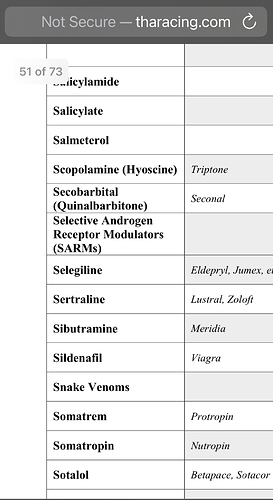You absolutely will get caught. Belladonna (scopolamine) is a controlled substance under both FEI and the TB Racing Industry. It is a class 4 substance, C class penalty.
You keep making these types of comments, which just proves how very little you actually know.
Please do a minute of research before making more false statements.
It’s not a good look.
So not a fact at all, just a guess.
I would be more inclined to compare Eventing to Steeplechasing. I do not see the comparison to flat racing at all.
NO work for a US federal agency that sees and has handled unapproved/ homeopathic c these products on a regulatory basis. You would be surprised. … what is out there and what people market
I would be delighted not to have to guess about the numbers–is there an Eventing body that publishes the number of horse deaths attributed to the sport per year in the same way the Jockey Club does? If so, please point me to it.
The FEI “Risk Management” section does report numbers for Rider “serious injuries and fatalities”.
In 2022, of 21,470 starters, .13% of riders suffered a serious or fatal injury.
That number is more than double the number of 2022 racehorse fatalities.
And yes, I realize that I’m comparing horses to riders, which is incorrect and still a guess–but not an entirely uninformed one. If you know where there are better stats re:horse deaths in eventing, I’d be happy to add them to my post.
(The percentage of horse falls–injury and/or death not specified–is 1.18% per starter.)
Your continued comments regarding how testing works, when it comes to racing, clearly shows how little you know.
I don’t care what you (think you) know or where you work.
Your statements show otherwise.
Not just in this thread, but in many others.
But again, that number only includes starts in races, not anything that happens outside the races.
Of the seven race horses that died in the last week just at Churchill Downs, weren’t two or three of them during training, not a race?
So the numbers are really apples and oranges anyway.
Event horses and riders might die outside of competitions, but not very often, I think.
Can you provide the stats for the number of TBs that are injured while training or racing, that have to be retired from the track? Obviously, while they aren’t dead, they are casualties of the sport.
The number of jockeys who are killed in a year, along with those who are injured? If the injury is sufficient that the jockey cannot return to their job, that would also make them a casualty of the sport.
@MHM and @ASB_Stars ASB_Stars
The stat I quoted re: horse falls comes from the FEI website and pertains to Eventers, not racehorses.
The FEI chart where I found the stats tracks only falls that take place in competition (which is the same way racehorse fatalities are monitored.)
Edited to add: My sport (racing) may have stuff to answer for–but they are transparent about their problems. Apparently eventing can’t say the same. Is there a list anywhere that shows how many horses died in competition while eventing in 2022? (Or any year for that matter?)
That’s why these comparisons are difficult to make–because one sport offers facts and figures and the other does not.
No, I cannot provide that info–for the same reason you can’t tell me how many eventing and/or show horses were injured or retired last year. No one keeps track of those numbers.
Possibly you are not aware that many, if not most, of the horses you’re calling “casualties of the sport” are capable of being successfully transitioned into other careers even though their racing days are over.
Actually, I stated that I would compare steeplechasing to racing as a far more reasonable option rather than eventing. While we can’t see any numbers, I am going to just guess that the numbers of horses coming off of the track grossly exceed those having to leave the show ring or eventing world because of an injury. You can look at percentages, but the reality is in the numbers. If you are producing 45K TBs in a year. how many will succeed at the track such that they stay there?
Yes, I do know that TBs often can do other things after they leave the track. However, what they can do is often limited by the damage incurred at the track. Hardware, chips, and old tendon injuries can stop a horse from being able to be useful as anything other than a pleasure horse, and temperaments have to align with the amateur who will be able to give them a home at that level.
Just an FYI, the last time anyone produced 45K TBs in a year was in the 1980s.
The current (2022) foal crop is 17K (and dropping).
2021: 18K
2020: 18K
2019: 19K
I don’t know if you realize what a complicated question that is.
Roughly 68% of TBs from recent foal crops make it to a race. In it’s simplest form, that’s “succeeding.” You were bred to race, you completed training, and you raced. That’s a darn good success rate in my eyes, especially given that horses will be horses and do things like off themselves as babies.
I don’t think any other discipline can quantify that kind of success like thoroughbreds can (except maybe standardbreds). Even if they could, I think we’d see around the same 68% given the nature of horses.
“Stay there” is a loaded phrase. Stay there until what? Until they die? Until they age out of being allowed to race? Is a 10 year old claimer with a spotty career and not even enough earnings to offset his training costs a greater success than a 3 year old champion whose breeding rights were purchased for $30M?
So @Jealoushe, I’m getting a lot of grief here for having an opinion.
What I don’t have is facts to back it up–though not for lack of trying on my part.
Racing is my sport and I can give you the facts and numbers on horse fatalities in competition there. Eventing? Not so much. A cynical person might wonder what’s being hidden. Or purposely not reported. Or maybe I just didn’t know the right places to look.
Since you were skeptical about my “just a guess”, I assume you must have access to the facts I can’t seem to find. Please feel free to share them and prove me wrong.
They will all leave the track at some point.
The question is, are they leaving to go on to a breeding career, or are they leaving the track in need of a home? If the latter, what issues has their career at the track caused that might affect their second career?
Which comes back around to my earlier question- how many horses are injured at the track such that they can no longer stay there, and make a living (pay for themselves)?
That’s still not an easy question.
How many horses are injured? Essentially all of them. But that’s true in any competitive discipline— if your horse is in regular work, eventually they are going to have some sort of injury. It may be as simple as a hoof bruise, it may be a life-ending open fracture. Most horses come back from their injuries without any problem.
How many of them can’t go on to a second career as a riding horse because of their injuries? That’s tricky to answer because there are so many factors at play.
My layup experience is dated, but 20 years ago I did layups for the largest racing stable in the country. I saw a lot of injuries. What I learned is Horse A and Horse B can sustain identical injuries, and Horse A might make a full recovery, race for years after the injury, and retire soundly into a riding career, while Horse B is never more than pasture sound.
Racing has made HUGE progress with aftercare. Huge. 20 years ago, most trainers didn’t give a second thought to what their horses could and couldn’t do after retiring from racing. Now I would argue almost everyone has a degree of awareness. There are people on the ground advocating for these horses every day. This heightened awareness is reflected in the prices people charge for OTTBs. 20 years ago, I was offered free TBs every day of my life (not an exaggeration)— most of them were sound and useful horses who I retrained and sold for what was good money at the time. Now people sell OTTBs straight off the track for more than double what I charged after putting a show record on them back then.
So @Jealoushe, I’m getting a lot of grief here for having an opinion.
What I don’t have is facts to back it up–though not for lack of trying on my part.
Racing is my sport and I can give you the facts and numbers on horse fatalities in competition there. Eventing? Not so much. A cynical person might wonder what’s being hidden. Or purposely not reported. Or maybe I just didn’t know the right places to look.
Since you were skeptical about my “just a guess”, I assume you must have access to the facts I can’t seem to find. Please feel free to share them and prove me wrong.
Caveat being that I’m coming at it from both worlds – racing is a massive industry compared to Eventing. They just don’t have the manpower or money to produce the same level of studies and statistics that racing does.
Caveat being that I’m coming at it from both worlds – racing is a massive industry compared to Eventing. They just don’t have the manpower or money to produce the same level of studies and statistics that racing does.
While on one hand, I agree that the money behind racing is massive compared to any other discipline (it’s why most equine veterinary medical studies are focused on racing and not other sport horses), I don’t think the cost to track horse accidents or fatalities would be that large given modern technology. Frankly, I had never considered why there aren’t databases for eventing or other disciplines, but I suspect it is a question of will, not way (or finances).
Frankly, I had never considered why there aren’t databases for eventing or other disciplines, but I suspect it is a question of will, not way (or finances).
I don’t know. I think the whole financial structure of the two sports is completely, totally, absolutely different.
The racing industry is fundamentally tied into the people who place bets, and the concern that those bettors feel like the wagering system is fair. Hence all the security at race tracks and drug testing protocols, along with all the rules about jockeys, trainers, etc.
I’m guessing that in eventing, it is nothing like that, except at maybe the highest levels. I think a lot of the officials at events are volunteers, and most people compete for fun, not for profit. So there is a lot less money floating around for any sort of studies.


